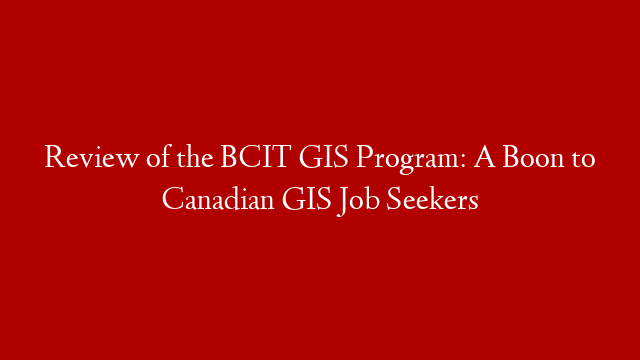When it comes to gaining an edge in the GIS job market, it pays to invest in an Advanced Diploma program to supplement the education you may have gained with regard to environmental science, geography or urban planning. While students often gain a cursory knowledge of GIS through their undergraduate work, it really does require a GIS focused program to set yourself apart in terms of the marketable GIS skills that employers often prefer.
I’ve examined several post graduate GIS programs in Canada and the US and I’m going to outline some of the best available. The first is that of the British Columbia Institute of Technology located in Burnaby. BCIT offers an Advanced Diploma in GIS that is designed for those with a university or college degree in a related discipline. BCIT offers the program to students on a full-time or part-time basis. This is a challenging program that will give you much of the technical knowledge you need to help set yourself apart in today’s job market.
The BCIT GIS Advanced Diploma program puts a strong emphasis on computer programming. They want graduates to not only be very skilled in customization and creating applications, but creating web applications as well. Students learn GIS as they apply to Java, Python, JavaScript, PHP among others. Thus, you will need to know about programming concepts and design before enrolling, though not necessarily familiar with any of the above languages in particular.
It should be noted that BCIT has admitted strong candidates whom did not have significant programming experience. In these cases, staff directed the potential applicants toward online programming tutorials to ensure they could gain basic programming fundamentals and to see if they would enjoy the programming aspect of the GIS courses. Students also use the web to present materials and thus need to know how to use HTML and an HTML editor before beginning courses. Students also find it highly beneficial to brush up on high-school math skills before classes begin.
In addition to the emphasis on programming, the BCIT program will give you an understanding in GIS as it relates to database structure, remote sensing, cartography as well as spatial analysis relating to both environmental and business applications. Students get hands-on experience with the latest ESRI and Autodesk GIS software and you will also be exposed to IT, management and organization issues as they relate to GIS. All your work culminates with a project/practicum course to gain real-world experience with a GIS employer.
Applicants must have completed a university degree, BC associate’s degree or have a diploma of technology before entering the program. Applicants with an international degree will need to submit for a full evaluation of credentials. In applying, students will also need to provide a resume and write a letter explaining their interest in the program and how they will prepare for the challenges it will bring. This is because the program is highly intensive with 30 hours per week in labs and lectures and a further 20 to 30 hours per week in coursework.
Past graduates explained to me that BCIT enabled them to stay within their particular fields of geology and marine biology respectively because they developed GIS as an extremely marketable skill through BCIT’s program.
BCIT’s relationship with employers for the final project/practicum can be extremely valuable because newfound GIS skills can be combined with a degree discipline which can lead to employment in the student’s chosen niche.
It should be noted that BCIT offers several GIS programs. They offer many of their introductory level GIS courses to people that are just looking to gain a working knowledge of how to use GIS applications by taking one or two courses. BCIT also offers a Bachelor of Technology Degree in GIS, aimed at students who, when they enter the program, have an Associate Degree or a Diploma of Technology and do not yet have a Bachelor’s Degree. The B.Tech in GIS consists of the same technical courses as the Advanced Diploma. As well, to earn the degree, the student must complete additional Management and Liberal Arts credits, and also complete six months of employment in the GIS field. Furthermore, in the fall of 2012, the Advanced Diploma program was offered in its entirety online through distance learning.



